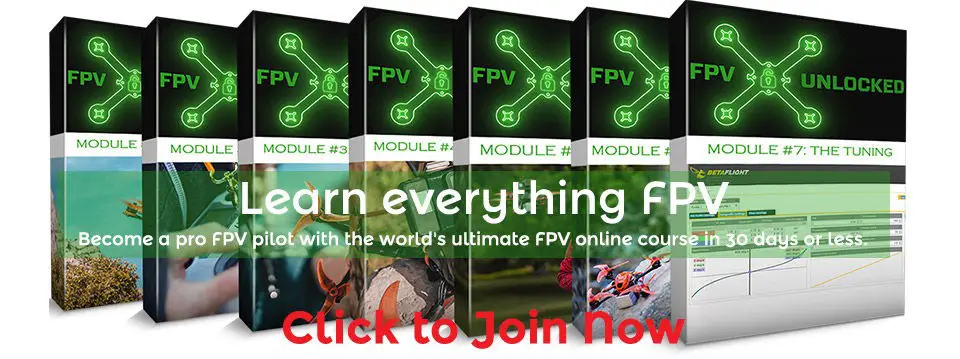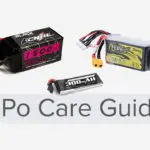If you are a casual pilot, you probably don’t need to know how the FPV drone works. But if you want to troubleshoot your drone, repair or replace failed components, and even build your own drone, you need to know how an FPV drone works.
In total, the camera on the FPV drone captures the video and sends it to the pilot through a transmitter and receiver. The pilot controls the drone using a radio. The FC processes the commands received, and orders the motors to spin at different speeds to achieve desired movements.
Let’s see what are the crucial components of an FPV drone and their respective functions.

Camera
The camera is the eye of your drone. It is responsible for capturing the FPV video, which is then fed to the pilot.
Drone cameras are super tiny so that they can fit into the drone, and keep the drone lightweight. Most of them do not produce high quality video footage though, due to the size limitation.
Some pilots mount action cameras onto their drone to record HD videos. Note that the video captured cannot be transmitted to your FPV goggles. It is mainly used for record-keeping or social media purposes.
Video Transmitter
Video transmitter, or VTX, is what defines FPV drones. Wireless transmission of video signal from the drone camera to the pilot is made possible with the video transmitter.
For FPV drones, the most common type of frequency band used is 5.8GHz, which is also the legally allowed frequency in the US. It has a decent amount of distance coverage as well as an obstacle penetration rate.
Higher or lower frequency VTX are available on the market but you should check with your country’s laws because certain frequency channel or bands are illegal to use without authorization. Managing the channel used by your video system is crucial to ensure an uninterrupted FPV experience while abiding the law.
Video Receiver: Goggles and Monitors

Your FPV drone won’t be complete without a video receiver. Video receiver or VRX picks up and process the video so that it can be displayed on a screen.
There are 2 types of gadgets that can pick up the video feed: FPV goggles and monitors. Let’s break down the pros and cons of each.
The goggles are the most preferred receiver. In fact, the use of goggles is what made the FPV drone land its mark on the technology field. It enables you to be fully immersed in your flight and that’s essentially the beauty of FPV drones for most.
Here are some of the best FPV goggles you can get.
For some pilots, goggles can be a bit disorienting. This is why they would rather opt to have a monitor feed.
Monitor receivers are not as popular as FPV goggles. You basically have a couple of inches of screen propped to your controller where you can see live the video feed from your drone. They are the standard before FPV goggles were invented.
For most FPV drone pilots, using a monitor is not that appealing because it doesn’t let the drone pilot immerse in the first-person view completely. However, using a monitor will give you a better field of view because your vision is not limited to what the drone camera feeds you. Moreover, FPV monitor is cheap!
Radio Controller or Transmitter
An RC or radio transmitter is basically a remote controller used to send instructions to our drone. There are 4 basic commands in term of drone movement, that we can give our drone:
Roll – rotation along the longitudinal axis. This will move your drone left/right
Pitch – rotate along the lateral axis. This will move your drone forward or backward
Yaw – rotating clockwise or counter counterclockwise. This will make your drone turn left or right.
Throttle – how fast you want the drone to go

The 4 basic movement commands mentioned above are what makes your drone move according to your will. Of course there are more sophisticated commands including turtle mode flipping, return home mode, and etc.
Many radio transmitters come with a telemetry system. It basically allows crucial information such as signal strength, battery voltage, and altitude to be sent back to your radio transmitter so that you can manage your flight better.
Read more about radio transmitter here.
Radio Receiver
A radio receiver, or RRX, is a simple yet important component of a drone. It basically picks up the radio signal from your radio transmitter, so that your drone can react to your command accordingly.

Flight Controller
A flight controller is the brain of your drone. It takes the command from your radio transmitter through a radio receiver. Then, it translates your commands and make the drone respond appropriately.
Say, you want to roll to the left by pressing the appropriate stick. The FC makes the left motors spin slower, and the right motors spin faster. As a result, the drone roll to the left.
Every flight controller is composed of a processor and basic sensors like a gyroscope and accelerometer. Other flight controllers also have extra peripherals included like sonar sensor, GPS, and more. If you’re into FPV drone racing, your flight controller probably focuses more on the gyroscope and gives up other sensors to free up more processing power.
If you’re flying FPV drones for leisure, it’s handy to have a range of sensors available to make your flying experience better and with ease.
Electronic Speed Controller
The electronic speed controller or ESC is a device that allows the flight controller to control the speed of your motors, specifically brushless motors.
Each of your brushless motors would require an ESC. Some people prefer to use a 4 in 1 ESC to save space along with other benefits.
ESC activates when your flight controller sends out a signal to either raise or lower the motor’s voltage. Changing the voltage of your drone causes its propeller to speed up or slow down.
There are different types of ESCs depending on your drone and its use. As for FPV drones, electronic speed controllers are usually the kinds that can handle higher current draw as well as higher refresh rates. A high current draw allows your FPV drone to reach faster speeds while a higher refresh rate makes your drone response more timely. These are incredibly important, especially if you’re dabbling into FPV drone racing.
This guide teaches you how to choose an ESC for your drone.
Motors and Propellers
Motors are responsible for running the propellers and hence, moving the drone. Brushless motors are regulated via the ESC.
When the motors are powered up and the props spin, they produce upward forces to lift the drone vertically. The forces produced need to be greater than gravity in order to lift the drone. Otherwise, the drone will stay on the ground, or descend if it is already in the air. When the force produced is the same as the gravity, the drone hovers in the air.
A range of movements is achievable by getting each motor to run differently. For instance, to move forward, the front motors spin at lower speed compared to the rear motors; to move to the left, the motors at the right will spin faster than those on the left. To rotate, a pair of motors diagonal to each other would rotate slower/faster than the other pair.
Batteries
The battery is an important part of your drone because it is what fuel your drone. You should definitely invest in having multiple sets of it, so you don’t have to wait for your battery to charge up before flying.
The common drone batteries available in the market are LiPo and LiHV batteries. In drone races, most people use LiPo for a more consistent performance.
You can learn more about batteries in this guide.
Power Distribution Board
A power distribution board, or PDB, is a crucial component that helps to distribute the right amount of power from the battery to the ESC, flight controller, camera and etc.
Modern drones usually have PDB integrated with either the ESC or flight controller to reduce the size and weight of the drone.
Final Words
There goes the main components you have in an FPV drone and their respective functions. I hope you have a clearer picture and what needs to be on your newly built drone and why you need them by now.
If you need help in picking those parts to build your drone, be sure to check out my recommendation at the top right corner of this website.


